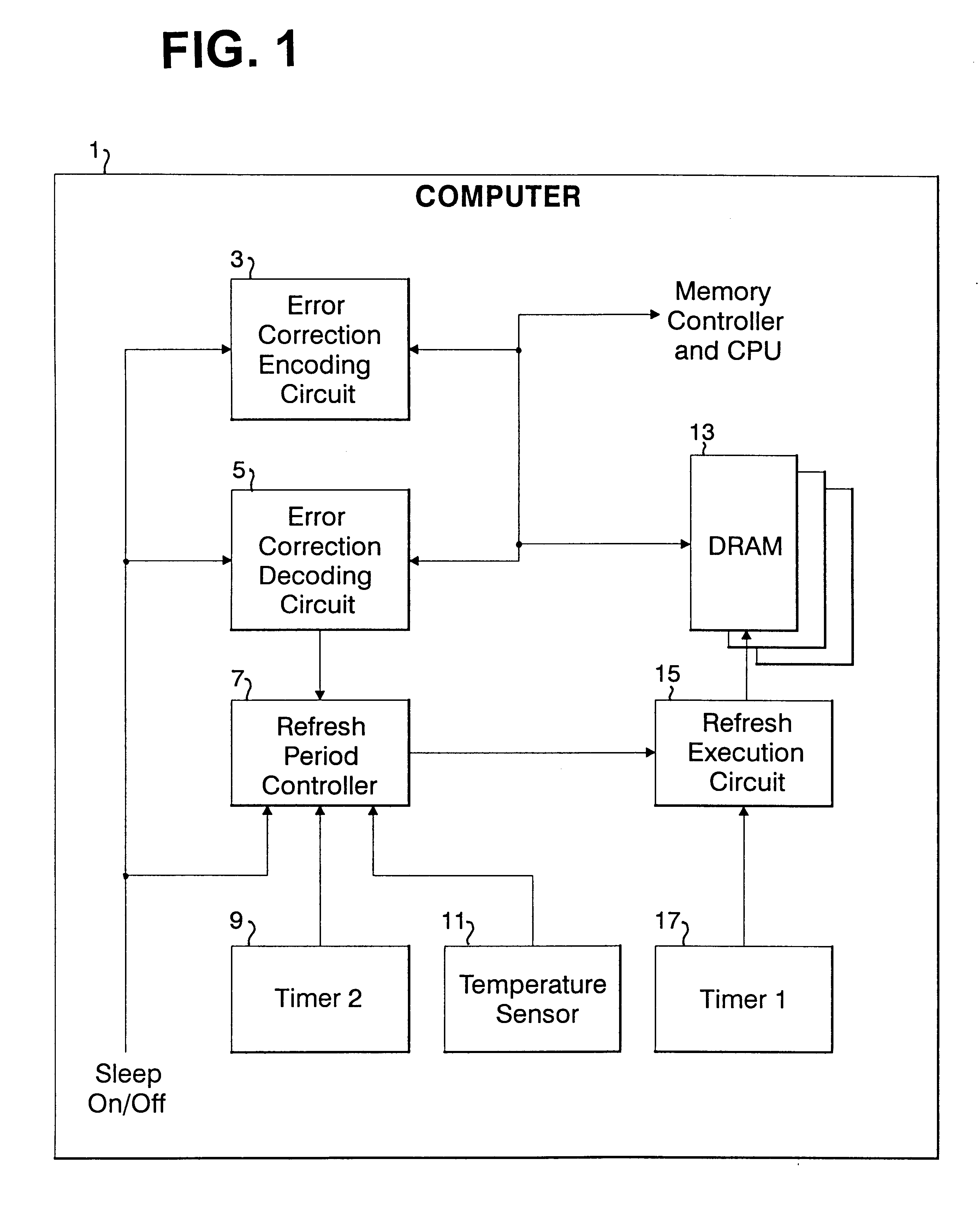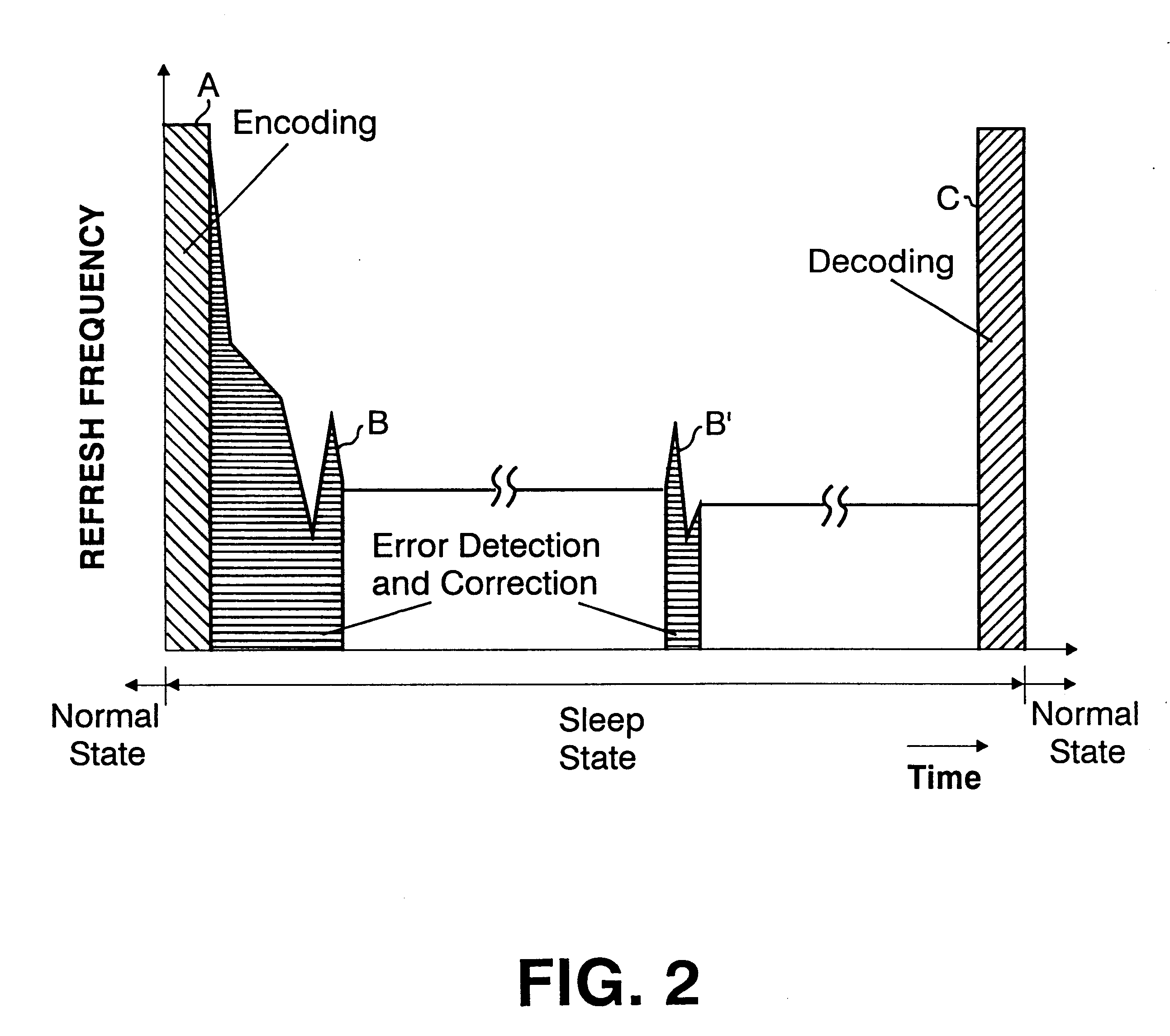These techniques have a high-speed error correction capability efficient for the
software errors, however, in comparison with techniques in the communication or in the HDD (Hard Disk Drive) and etc, they only provide a relatively poor error correction capability.
However because of a
countermeasure for
software errors, the error detection / correction circuit has only poor error correction capability, In addition, because it is mounted on the
DRAM chip, this technique has defects that it is more expensive than a normal
DRAM chip and it is impossible to alter or select the error correction capability in accordance with a request from a
system designer, independently of the
DRAM chip.
Furthermore, this US patent does not specify the time to perform this technique and only discloses the synchronization of the refresh operation and the operation of the error detection / correction.
However, this US patent mentions only the synchronization of the refresh operation and the operation of the error detection / correction and does not specify the time to perform this technique.
Because the refresh operation is always synchronized with the error detection / correction operation, even if the
power consumption is reduced by extending the refresh period, the power consumption is increased by the error detection / correction operation.
On the contrary, because the refresh operation is always synchronized with the error detection / correction, operation, it may assume high-speed but lower error correction capability.
Furthermore, because it is mounted on the DRAM
chip, this technique has defects that it is more expensive than a normal DRAM
chip and it is impossible to alter or select the error correction capability in accordance with a request from a
system designer, independently of the DRAM
chip.
In the whole of this US patent, it is also supposed that because under a consideration that errors will be accumulated so that an error
recovery cannot be performed unless the error detection / correction operation is performed every refresh operation because errors occur in a condition in which the refresh period is maximized more frequently than in the
normal state, driven by necessity, the error detection / correction operation is performed at each refresh operation.
In other words, it is considered that both of extending the refresh period and not performing the error detection / correction operation every refresh operation are contradictory in view of reliability.
Therefore, the increase of the power consumption caused by performing the refresh operation and the error detection / correction operation at the same timing becomes a problem.
From this viewpoint, mounting the error detection / correction circuit on the DRAM chip is mandatory, however, the standard DRAM chip cannot be used.
However, because it does not disclose any error correction, and discloses the time to start using DRAM is after any error does not occur, and discloses when the number of the refresh operation is periodically set at an appropriate period, data stored in the DRAM is copied to an
external storage device, it is understood that the time to reduce the number of refresh operations first time in this publication is immediately after the computer is powered on.
Therefore, if meaningful information is stored in the DRAM it is impossible to simply apply this technique disclosed in this publication.
Furthermore, because when the number of the refresh operation is periodically set at an appropriate period, data stored in the DRAM is copied to an
external storage device, extra power is consumed.
Furthermore, because the refresh period set based on the test at the power-on, the technique disclosed in the TDB1 cannot be performed if the meaningful information is stored in the DRAM.
That is, since, as well as some
conventional technique, the error correction / checking circuit and the compression circuit are mounted on the DRAM chip, it is more expensive than a normal DRAM chip and it is also impossible to alter or select the error correction capability.
Furthermore, for reliably storing the
refresh cycle for each segment, the SRAM is required, then the cost further increases.
By using the above described
conventional technique, it is difficult to obtain a longer refresh period for DRAM which stores meaningful data, and whereby to provide highly reliable data storage and low power consumption.
For example, those are not appropriate for following applications.
As a result, an operation that the contents in the main memory is stored into a hard disk becomes unnecessary.
As described above, using the
conventional technique it is difficult to adequately extend the refresh period for the DRAM in storing meaningful data.
The change of the refresh period is limited to a range within which the refresh execution circuit can cope with the updated refresh period because the refresh period that can be set for the refresh execution circuit is unrelated to the optimal range for power consumption.
Although it depends on the type of encoding used, the decoding process may not be performed even after the sleep mode has been terminated.
 Login to View More
Login to View More  Login to View More
Login to View More 


